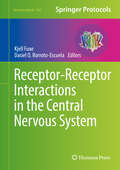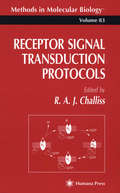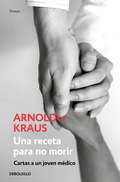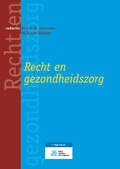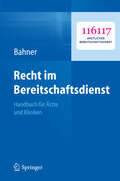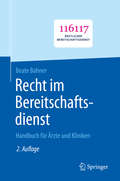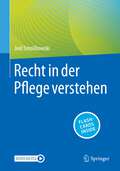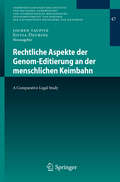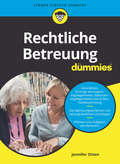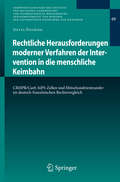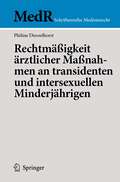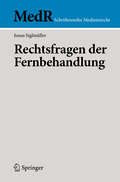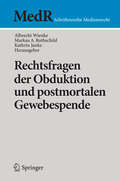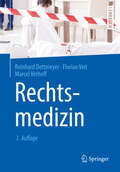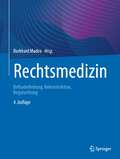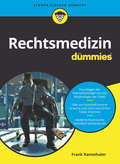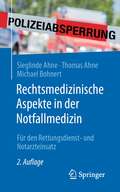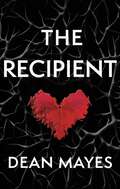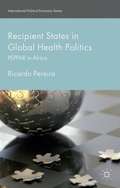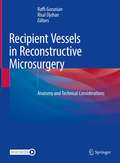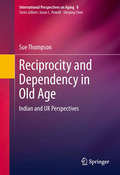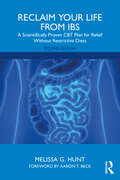- Table View
- List View
Receptor Binding Techniques
by Mary KeenThis cutting-edge collection of step-by-step experimental protocols demonstrates the power of radioligand binding for studying a wide variety of receptors. The methods can be applied to G protein-coupled receptors, receptors with integral ion channels, and sites other than receptors, such as guanine nucleotide binding proteins, enzymes, transporters, and mRNA. The individual protocols encompass many different preparations, ranging from solubilized receptors, through membrane preparations, intact cells, and autoradiography in tissue slices, to PET and SPECT analysis of binding in living human brain. Along with the detailed, easily reproducible instructions, the protocols also address the problems inherent in the basic binding technique, such as common experimental artifacts and the definition of receptor sites, as well as problems associated with the use of particular ligands and receptor preparations. Receptor Binding Techniques shows clearly how these methods can be adapted to many different applications and fully utilized in drug discovery programs.
Receptor-Receptor Interactions in the Central Nervous System (Neuromethods #140)
by Kjell Fuxe Dasiel O. Borroto-EscuelaThis volume covers methodologies, ranging from the molecular level to the network level, used to study receptor-receptor interactions in heteroreceptor complexes inside the central nervous system. The chapters in this book cover topics such as biochemical binding techniques; receptor autoradiography; superfused synaptosome techniques; RTK-GPCR interaction; fluorescence and bioluminiscence energy transfer methods, Co-IP cytometry-based FRET; and novel bioinformatic approaches to understand membrane heteroreceptor complexes and the global panorama of their receptor-receptor interactions. In Neuromethods series style, chapters include the kind of detail and key advice from the specialists needed to get successful results in your laboratory.Cutting-edge and thorough, Receptor-Receptor Interactions in the Central Nervous System is a valuable resource for any scientist or researcher interested in this field of study.
Receptor Signal Transduction Protocols
by R. A. ChallissAn outstanding collection of state-of-the-art methods from leading experts for interrogating ligand-receptor and receptor-effector interactions. The methods emphasize the regulation of G protein-coupled receptors and focus on receptor characterization, methods for investigating how receptors couple to G proteins, and approaches to studying how receptor expression and function is regulated. The easily reproducible protocols include chimeric receptor construction, antibody generation, transient and stable transfection methods, in situ hybridization, as well as immunocytochemistry, functional assays of G protein function, antisense methods for defining receptor-effector coupling pathways, and many more.
Una receta para no morir: Cartas a un joven médico
by Arnoldo Kraus«Arnoldo Kraus ha hecho de su vida una pasión por la muerte, o más bien una pasión por la vida y por el bien morir.» Eduardo Matos Moctezuma En esta obra, Arnoldo Kraus ofrece una visión integral y sucinta sobre saberes, coyunturas y deudas que ha debido adquirir, enfrentar y resolver a lo largo de sus años en el ejercicio de la medicina. El sustento de estas reflexiones es la experiencia práctica, pero no sólo ella; también varias lecturas, una posición de compromiso ético y la certeza de no saberlo todo. Tanto los aspirantes a médico como los lectores en general encontrarán aquí motivos para confiar en que no se ha roto definitivamente el vínculo entre humanismo y medicina.
Recht en gezondheidszorg
by H.E.G.M. Hermans M.A.J.M. BuijsenRecht en gezondheidszorg is een inleiding in het recht dat van betekenis is voor de gezondheidszorg. Het is een wegwijzer van dat recht, waarbij de nieuwste ontwikkelingen op dit gebied ter sprake komen. In het boek wordt onder meer aandacht besteed aan organisatie en structuurwetgeving, financieringswetgeving, patiëntenrechten en medische aansprakelijkheid.In dit boek wordt verder uitvoerig stilgestaan bij de betekenis van medisch-ethische vraagstukken en medisch-ethische wetgeving voor de gezondheidszorg. Hierdoor worden de dilemma’s duidelijk waarmee individuele beroepsbeoefenaren, managers in de zorg en gezondheidsjuristen meer en meer worden geconfronteerd.Recht en gezondheidszorg is primair geschreven voor studenten van universiteiten, hbo- en managementopleidingen in de gezondheidszorg. Daarnaast is het goed bruikbaar voor professionals in de gezondheidszorg die een beeld willen krijgen van de actuele stand van zaken met betrekking tot juridische vraagstukken op het terrein van de gezondheidszorg.
Recht im Bereitschaftsdienst
by Beate BahnerIm Blickpunkt des Buchs stehen die Fragen, mit denen Ärzte im Rahmen ihres Notdienstes/Bereitschaftsdienstes konfrontiert sind. Angefangen bei der Pflicht zur Teilnahme am Bereitschaftsdienst werden die Themen Behandlung, Suizid, Zwangseinweisung in die Psychiatrie, Verdacht auf Kindesmisshandlung und Feststellen des Todes erläutert. Auch Fragen der Haftung, das Vorgehen im Schadensfall sowie die Abrechnung im Bereitschaftsdienst werden behandelt. Die Autorin führt zahlreiche Praxisfälle an und berücksichtigt umfassend die aktuelle Rechtsprechung.
Recht im Bereitschaftsdienst: Handbuch für Ärzte und Kliniken
by Beate BahnerIm Blickpunkt des Buchs stehen die Fragen, mit denen Ärzte im Rahmen ihres Notdienstes/Bereitschaftsdienstes konfrontiert sind. Angefangen bei der Pflicht zur Teilnahme am Bereitschaftsdienst werden die Themen Behandlung, Suizid, Zwangseinweisung in die Psychiatrie, Verdacht auf Kindesmisshandlung und Feststellen des Todes erläutert. Auch Fragen der Haftung, das Vorgehen im Schadensfall sowie die Abrechnung im Bereitschaftsdienst werden behandelt. Die Autorin führt zahlreiche Praxisfälle an und berücksichtigt umfassend die aktuelle Rechtsprechung.
Recht in der Pflege verstehen
by Joel SmolibowskiRecht richtig verstehen und souverän handeln!Dieses Buch richtet sich an Auszubildende, Berufsanfänger und gestandene Profis in der Pflege, denen ein echtes Verständnis und ein sicherer Umgang mit dem Recht wichtig sind. Es schafft die Grundlage für einen sicheren Umgang mit juristischen Texten, rechtlichen Vorgaben und Sachverhalten und damit Souveränität in der täglichen Arbeit. Wichtige Ausbildungsinhalte finden sich in alltäglichen Arbeitssituationen wieder. Dabei orientiert sich der Autor ausschließlich an der Rechtsprechung und der Anwendungspraxis der Behörden. Alle akademischen Streitigkeiten werden beiseitegelassen. Wichtige Dokumente, wie Arbeitsvertrag, Patientenverfügung, Antrag auf Betreuung, Vollmachten und Bescheide werden direkt am Wortlaut einer jeweiligen Standardausführung– Klausel für Klausel – Satz für Satz erklärt. Denn das Arbeitsleben ist vollständig verrechtlicht und die Vorgaben stellen eine immer größere tägliche Herausforderung dar. Worauf basiert eigentlich unser Rechtssystem und wie werden Urteile gefällt? Mit digitalen Lernkarten (Flashcards) für eine gelungene Wissensüberprüfung.
Rechtliche Aspekte der Genom-Editierung an der menschlichen Keimbahn: A Comparative Legal Study (Veröffentlichungen des Instituts für Deutsches, Europäisches und Internationales Medizinrecht, Gesundheitsrecht und Bioethik der Universitäten Heidelberg und Mannheim #47)
by Jochen Taupitz Silvia DeuringDas Buch enthält 19 Landesberichte und eine rechtsvergleichende Analyse der rechtlichen Regelungen zum Verfahren der Genom-Editierung an der menschlichen Keimbahn. Es wird herausgearbeitet, welche gemeinsamen Werte die verschiedenen Rechtsordnungen verbinden und welche Unterschiede bestehen. Auf dieser Grundlage wird untersucht, ob eine internationale Regulierung der Thematik möglich ist und wie diese ausgestaltet sein könnte. Zudem soll untersucht werden, in wie weit die Regelungen anderer Länder als Modell für die deutsche Gesetzgebung dienen können.
Rechtliche Betreuung für Dummies (Für Dummies)
by Jennifer OttenAls rechtlicher Betreuer muss man vieles wissen. Jennifer Otten stellt Ihnen in diesem Buch die wesentlichen Regelungen in der Beziehung zwischen Betreuer und Betreuten dar. Sie erklärt Ihnen die Bedeutung und das Zusammenspiel der Gerichte und Behörden im Betreuungsverfahren. Dieses Buch ist anwendungsorientiert und praxisnah, eine Schritt-für-Schritt-Anleitung für rechtliche Betreuer voller Checklisten, Tipps und Tricks, die Sie bei Ihrer Tätigkeit als ehrenamtlicher Betreuer unterstützen oder Ihnen den Einstieg in die berufliche Betreuung erleichtern.
Rechtliche Herausforderungen moderner Verfahren der Intervention in die menschliche Keimbahn: CRISPR/Cas9, hiPS-Zellen und Mitochondrientransfer im deutsch-französischen Rechtsvergleich (Veröffentlichungen des Instituts für Deutsches, Europäisches und Internationales Medizinrecht, Gesundheitsrecht und Bioethik der Universitäten Heidelberg und Mannheim #49)
by Silvia DeuringDieses Buch befasst sich mit der rechtlichen Bewertung von modernen Verfahren der Intervention in die menschliche Keimbahn, d.h. von gentechnischen Veränderungen am Menschen, die an die nachfolgenden Generationen weitergegeben werden. Neuartige Methoden wie die CRISPR/Cas9-Technik, der Mitochondrientransfer und die Möglichkeit der Herstellung artifizieller Gameten aus hiPS-Zellen stellen das Recht vor neue Herausforderungen. Insbesondere ist fraglich, ob die aktuell bestehenden Gesetze diese neuen Verfahren noch erfassen oder ob gesetzliche Lücken entstanden sind. Dieses Buch analysiert in diesem Zusammenhang die Rechtslage in Deutschland und Frankreich. Es behandelt dabei sowohl genetische Veränderungen an menschlichen Keimbahnzellen zur Forschung in vitro als auch solche, die in der Geburt von Menschen münden. Zudem wird der Frage nachgegangen, ob das deutsche Verfassungsrecht einer Anwendung dieser Verfahren grundsätzlich entgegensteht oder ob eine gesetzliche Zulassung in der Zukunft unter bestimmten Voraussetzungen möglich wäre. Auf der Grundlage des Rechtsvergleichs sowie der verfassungsrechtlichen Untersuchung formuliert das Buch einen Regelungsvorschlag, sowohl zur Beseitigung aktuell bestehender rechtlicher Lücken und Unklarheiten als auch im Hinblick auf eine (künftige) mögliche Anwendung der Verfahren.
Rechtmäßigkeit ärztlicher Maßnahmen an transidenten und intersexuellen Minderjährigen (MedR Schriftenreihe Medizinrecht)
by Philine DiesselhorstDieses Buch untersucht die rechtlichen Fragen, die sich im Rahmen der ärztlichen Behandlung transidenter und intersexueller Minderjähriger stellen. Im ersten Teil des Werkes werden die medizinisch-biologischen Grundlagen von Transidentität und Intersexualität sowie der medizinische und gesellschaftliche Umgang mit beiden Phänomenen dargestellt. Anschließend folgt eine Auseinandersetzung mit der Bedeutung des Geschlechts im Recht und der personenstandrechtlichen Behandlung transidenter und intersexueller Personen. Im darauffolgenden Hauptteil des Werkes werden zunächst die allgemeinen Voraussetzungen rechtmäßigen ärztlichen Handelns analysiert und sodann auf die speziellen Fallgruppen der Transidentität und Intersexualität angewendet, wobei ein besonderes Augenmerk auf die Indikationsstellung und die Einwilligung durch einen Minderjährigen selbst beziehungsweise durch die sorgeberechtigten Eltern gelegt wird. Zudem erfolgt eine vertiefte Analyse des § 1631e BGB. Schließlich wird die rechtliche Behandlung beider Fallgruppen unter Berücksichtigung der bestehenden tatsächlichen Unterschiede in einen Vergleich gesetzt und die Frage erörtert, ob die aktuelle Rechtslage den jeweiligen spezifischen Anliegen beider Fallgruppen gerecht wird.
Rechtsfragen der Fernbehandlung (MedR Schriftenreihe Medizinrecht)
by Jonas SiglmüllerDieses Buch analysiert und bewertet die Rechtslage zur Durchführung medizinischer Behandlungen bei örtlichem und/oder zeitlichem Versatz auf dem Gebiet des Standesrechts, des Haftungsrechts, des Werberechts, des Rechts der medizinischen Verordnungen, des SGB V-Leistungsrechts, des Medizinprodukterechts und des Datenschutzrechts.
Rechtsfragen der Obduktion und postmortalen Gewebespende
by Albrecht Wienke Kathrin Janke Markus A. RothschildBei über 95 % aller Verstorbenen in Deutschland bestehen nach wie vor keine autoptisch gesicherten Erkenntnisse über die eigentliche Todesursache und etwaige Begleiterkrankungen. Die auf einer solchen unsicheren Datenlage beruhenden gesundheitspolitischen Entscheidungen zu Disease-Management-Programmen, zu Prävention und strukturellen Maßnahmen der Krankenversorgung entsprechen damit nicht der erforderlichen Evidenz. Dies hat zugleich negative Auswirkungen auf die Qualität ärztlicher Diagnostik und Therapie und somit auf die Patientensicherheit. Zudem machen es die sehr unterschiedlichen Rechtsgrundlagen in den Landesgesetzen über das Leichen-, Bestattungs- und Friedhofswesen den betroffenen Angehörigen und den Mediziner in der praktischen Umsetzung der oft widerstreitenden Interessen nicht leicht. Die klinische und anatomische Sektion ist nach derzeit allgemeiner Meinung auch im wissenschaftlichen Interesse oder zu Ausbildungszwecken ohne Zustimmung des Verstorbenen oder seiner Angehörigen unzulässig. Die medizinische Forschungs- und Ausbildungssituation wird durch diese Zustimmungslösung nachhaltig beeinträchtigt; eine erweiterte Widerspruchslösung könnte hierbei viele Hindernisse in der praktischen Handhabung beseitigen. Die DGMR hat sich in ihren aktuellen Empfehlungen daher für eine gesetzliche Abkopplung der postmortalen Gewebespende von der Organtransplantation im Transplantationsgesetz ausgesprochen, um die seit Jahren niedrige Obduktionsquote in Deutschland nachhaltig zu verbessern. Der vorliegende Tagungsband gibt die Referate und die Empfehlungen der DGMR zur Obduktion und postmortalen Gewebespende wieder.
Rechtsfragen der Personalisierten Medizin
by Albrecht Wienke Christian Dierks Kathrin JankeDie Personalisierte Medizin (auch Individualisierte Medizin) eröffnet neue Perspektiven für Prädiktion, Diagnostik, Therapie und Medikamentenentwicklung. Die Auswahl von Medikation und Dosierung in Abhängigkeit individueller Besonderheiten durch den Nachweis von Biomarkern und die Abstimmung der pharmakotherapeutischen Optionen auf die molekularen Besonderheiten eines Tumors in der Onkologie sind Beispiele dieses medizinischen Konzepts. Die damit einhergehenden Rechtsfragen berühren das Arztrecht, das Arzneimittelrecht, das Recht der Krankenversicherungen und das Datenschutzrecht. Die DGMR hat in ihrem Einbecker Workshop im Frühjahr 2013 mit Experten der Medizin und der Rechtswissenschaften die Rechtsfragen der Personalisierten Medizin in einem Workshop erarbeitet und dazu Empfehlungen beschlossen. Damit liegen zusammengefasste Erkenntnisse in diesem noch jungen Bereich vor, die die weiteren Diskussionen bereichern sollen.
Rechtsmedizin (Springer-Lehrbuch)
by Reinhard Dettmeyer Florian Veit Marcel VerhoffWie bestimmt man den Todeszeitpunkt? Wie werden die verschiedenen Gewalteinwirkungen diagnostiziert? Wie lässt sich ermitteln, welche Rolle Alkohol bei der Todesursache spielt? Und wie sehen die Rechtsbeziehungen zwischen Arzt und Patient aus?Über die Arbeit des Rechtsmediziners bestehen sehr unterschiedliche Vorstellungen. Mit dem Lehrbuch Rechtsmedizin werden diese Vorstellungen konkret. Kompakt und sehr praxisnah werden alle Themen der Rechtsmedizin behandelt. Und das ganz übersichtlich:Zahlreiche Fallbeispiele geben einen Einblick in die PraxisDefinitionen machen sofort klar, worum es gehtMehr als 100 Tabellen bringen die Fakten auf den Punkt und helfen beim schnellen LernenMehr als 220 Abbildungen machen die Rechtsmedizin anschaulichMerksätze für das Wichtigste in einem SatzHier finden Sie alles Notwendige für die Prüfung: die ärztliche Leichenschau, eine ausführliche Forensik, das Medizinrecht und vieles mehr. Durch die praxisnahe Darstellung ist das Buch sowohl für Studierende als auch für Ärzte und Mitarbeiter von Polizei- und Justizbehörden hervorragend geeignet.
Rechtsmedizin
by Reinhard Dettmeyer Florian Veit Marcel VerhoffWie bestimmt man den Todeszeitpunkt? Wie werden die verschiedenen Gewalteinwirkungen diagnostiziert? Wie lässt sich ermitteln, welche Rolle Alkohol bei der Todesursache spielt? Und wie sehen die Rechtsbeziehungen zwischen Arzt und Patient aus?Über die Arbeit des Rechtsmediziners bestehen sehr unterschiedliche Vorstellungen. Mit dem Lehrbuch Rechtsmedizin werden diese Vorstellungen konkret. Kompakt und sehr praxisnah werden alle Themen der Rechtsmedizin behandelt. Und das ganz übersichtlich:Zahlreiche Fallbeispiele geben einen Einblick in die PraxisDefinitionen machen sofort klar, worum es gehtMehr als 100 Tabellen bringen die Fakten auf den Punkt und helfen beim schnellen LernenMehr als 220 Abbildungen machen die Rechtsmedizin anschaulichMerksätze für das Wichtigste in einem SatzHier finden Sie alles Notwendige für die Prüfung: die ärztliche Leichenschau, eine ausführliche Forensik, das Medizinrecht und vieles mehr. Durch die praxisnahe Darstellung ist das Buch sowohl für Studierende als auch für Ärzte und Mitarbeiter von Polizei- und Justizbehörden hervorragend geeignet. Die vierte Auflage wurde sorgfältig aktualisiert und erweitert.
Rechtsmedizin: Befunderhebung, Rekonstruktion, Begutachtung
by Burkhard MadeaDIE Rechtsmedizin - einzigartig im deutschsprachigen Raum Umfassend Alle aktuellen Erkenntnisse und Standards der RechtsmedizinFundort für spezielle DetailfragenGültig im gesamten deutschsprachigen Raum (Deutschland, Österreich, Schweiz)Die Basis für jedes GutachtenSicherheit für die Facharztprüfung Rechtsmedizin Praxisrelevant Leitlinienbasierte praktische Anleitungen zu Vorgehensweisen und Methoden für die tägliche ArbeitFundierte Übersichten und ChecklistenKommentierte Gesetzestexte und FalldarstellungenKooperation und Schnittstellenmanagement zwischen Sachverständigen, Behörden und Institutionen NEU u.a. Neueste molekularbiologische Analytik, z. B. prädiktive Phänotypisierung und molekulare AltersschätzungNeueste toxikologische Analytik, z. B. neue psychoaktive SubstanzenInfektionsdiagnostikCOVID-19 assoziierte TodesfälleKlinische Rechtsmedizin und forensische SexualmedizinAlkoholismusmarkerNeueste gesetzliche Regelung, z. B. § 81e StPO, neue Psychoaktive-Stoffe-GesetzAktuelle Entwicklungen zur Akkreditierung und Qualitätssicherung Nach den Leitlinien und Vorgaben DGRM Deutsche Gesellschaft für RechtsmedizinGTFCh Gesellschaft für Toxikologische und Forensische ChemieEU RecommendationIALM International Academy of Legal MedicineISFG International Society for Forensic Genetics „Rechtsmedizin“ bietet für jede Fragestellung der Rechtsmedizin eine Antwort – als verlässliche Informationsquelle und Nachschlagewerk. Für Rechtsmediziner, Pathologen, Toxikologen, Biologen, Kriminologen, Kriminalisten und Juristen in Klinik, Labor, Sektionssaal und Gericht.
Rechtsmedizin für Dummies (Für Dummies)
by Frank RamsthalerWir alle kennen die Forensik aus verschiedenen Filmen und Serien. Doch jetzt besuchen Sie einen Kurs in Rechtsmedizin an der Universität? Mit diesem Buch decken Sie Mythen der Filme und Serien auf und entdecken die reale Welt der Rechtsmedizin. Dieses Buch bietet die ideale Basis und erklärt verständlich die Grundlagen. Von Pathologie und Physiologie des Todes, über die Identifizierung eines unbekannten Toten bis zu modernen forensischen Techniken und vieles mehr finden Sie in diesem Buch.
Rechtsmedizinische Aspekte in der Notfallmedizin: Für den Rettungsdienst- und Notarzteinsatz
by Sieglinde Ahne Thomas Ahne Michael BohnertDieses Taschenbuch liefert Mitarbeitern im Rettungsdienst und Notärzten anhand von zahlreichen Fallbeispielen rechtsmedizinisches Praxiswissen für die Erstversorgung von Notfallpatienten. Themen sind u.a. Leichenschau, Verhalten am Tatort, stumpfe und scharfe Gewalt, Strangulation, Schussverletzungen, Tötungsdelikte und Suizid. Auch Besonderheiten bei plötzlichem Kindstod, Kindesmisshandlung und Sexualdelikten werden berücksichtigt. Die 2. Auflage erscheint komplett überarbeitet, aktualisiert und um das Thema Kinderschutz erweitert.
The Recipient: A Pyschological Medical Thriller
by Dean MayesHer heart is dying.Casey Schillinge is a vivacious young woman on the verge of making her mark on the world. While backpacking, she is struck down by a tropical disease and suffers cardiac failure. But at the eleventh hour, Casey receives a life-saving heart transplant and a rare second chance to begin again.Her new heart is changing her.Three years later, Casey has become a withdrawn shell of her former self: she is estranged from her loved ones, afraid of open spaces and rides the line between legitimate and criminal work. The worst of her troubles come in the form of violent night terrors; so frightening that she resorts to extreme measures to keep herself from sleeping.What is her heart revealing?When she can take no more, she embarks on a desperate search for the source of her dreams. In so doing, she makes a shocking discovery surrounding the tragic fate of the donor whose heart now beats inside her chest. As she delves deeper into the mystery of her donor, she realizes her dreams are not a figment of her imagination, but a real-life nightmare.Will her heart end up killing her after all?"As Dean takes you on an adrenaline-fuelled ride that twists to a kicker of a climax, ultimately uncovering a tale of human horror that is all too real, he will keep you guessing throughout as you try and figure out just who the good guys and the bad guys are. A word of warning – trust no-one as you race towards the very satisfying conclusion of this gripping psychological thriller!" - Marcia B, Book Muster Down Under"Entwining very real social issues with fast-paced adventure and fascinating dream sequences, Mayes has created a story that successfully combines suspense, dark humor, cultural references, action and outright horror, an intense examination of what motivates the terrible crimes perpetrated in the novel. Be prepared for a wild ride!" - Abbie Williams, author of The Shore Leave Cafe series"Overall, a great read that was fascinating medically and had great character development." - Christina Boswell, Manhattan Book ReviewBe sure to also read Dean Mayes' other novels:The Hambledown DreamGifts of the PeramangkThe Artisan Heart
Recipient States in Global Health Politics
by Ricardo PereiraEven if constrained in their international choices, recipient countries of global health programmes hold the capacity to autonomously define and pursue their own strategies, policies, and ultimately attain political goals. This is comparatively demonstrated through the analysis of PEPFAR's implementation in Botswana, Ethiopia and South Africa.
Recipient Vessels in Reconstructive Microsurgery: Anatomy and Technical Considerations
by Raffi Gurunian Risal DjohanThis book offers a comprehensive review of reconstructive microsurgery with an emphasis on the recipient vasculature. Chapters describe the anatomy, exposure, and technical considerations of recipient vessels in reconstructive microsurgery. The book strives to fill that void of literature covering recipient vessels and their surgical exposure for microvascular anastomosis. Alongside nuanced description for each particular body structure, the chapters will provide illustrations and short video clips on how to prepare these essential vessels. The book is the accumulation of the editors’ many years of experience in Asia, Europe, and the United States and also features contributions from world experts. Recipient Vessels in Reconstructive Microsurgery -- Anatomy and Technical Considerations is a must-have resource for trainees and residents as well as surgeons working in plastic surgery and microsurgery.
Reciprocity and Dependency in Old Age
by Sue ThompsonThis book highlights (1) the significance of reciprocity for the maintenance of self-esteem in old age and (2) the negative implications for the well-being of dependent older people when that significance goes unrecognized and, as a consequence, opportunities to give back to society, as well as take from it, are not facilitated by those in a position to do so. The discussion draws on research undertaken in the UK and Southern India into the extent to which having the self-perception of being valued in the world is important to older people in receipt of care support and whether, in their experience, this is recognized by others. The author presents an analysis of theoretical insights from leading thinkers across a broad range of literature and from several disciplines, including social theory, social work, philosophy, and gerontology. The author also gives voice to the perspectives of those dependent older people not often heard because of marginalizing and disempowering processes that contribute to their having little opportunity to be heard in the first place. The emphasis of this book is on aspiration to a meaningful life and continuing personal growth as offering a challenge to dominant discourses the equate old age with decline.
Reclaim Your Life from IBS: A Scientifically Proven CBT Plan for Relief Without Restrictive Diets
by Melissa G. HuntReclaim Your Life from IBS teaches a number of skills that can directly reduce the impact of gastrointestinal symptoms in a person’s life. The book explores the differential diagnosis of irritable bowel syndrome (IBS) and the current scientific models of what causes IBS. It teaches the reader the cognitive model of stress management using cognitive-behavioral therapy and helps readers learn to identify their negative beliefs and reframe them more accurately. It also guides readers to reduce avoidance and helps them understand how to use dietary modifications and medications wisely, rather than reactively. In this second edition, numerous case examples throughout illustrate the application of these core CBT skills to IBS-related thoughts and experiences, and new material is included on exercise, diet, and medications. This book is a proven self-help book for people with IBS, as well as being useful as a treatment manual for clinicians who work with patients with IBS.

